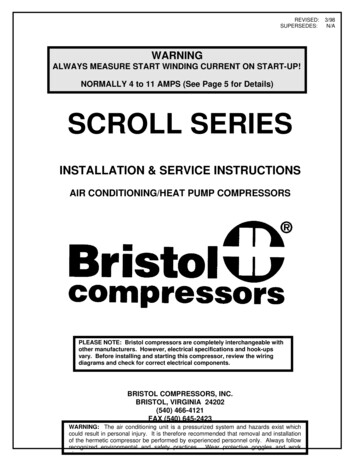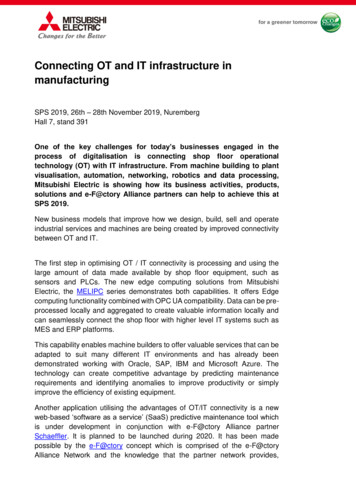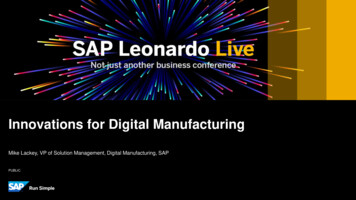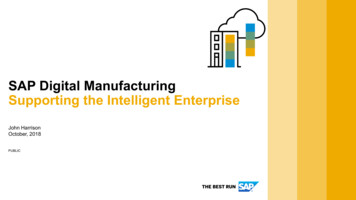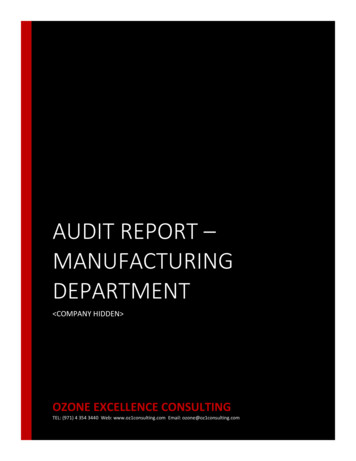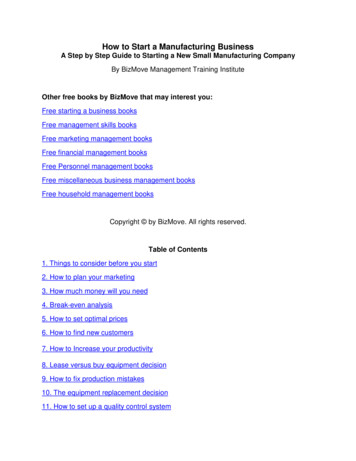
Transcription
How to Start a Manufacturing BusinessA Step by Step Guide to Starting a New Small Manufacturing CompanyBy BizMove Management Training InstituteOther free books by BizMove that may interest you:Free starting a business booksFree management skills booksFree marketing management booksFree financial management booksFree Personnel management booksFree miscellaneous business management booksFree household management booksCopyright by BizMove. All rights reserved.Table of Contents1. Things to consider before you start2. How to plan your marketing3. How much money will you need4. Break-even analysis5. How to set optimal prices6. How to find new customers7. How to Increase your productivity8. Lease versus buy equipment decision9. How to fix production mistakes10. The equipment replacement decision11. How to set up a quality control system
1. Things to Consider Before You StartThis guide will walk you step by step through all the essential phases of starting asuccessful manufacturing business. To profit in a manufacturing based business, youneed to consider the following questions: What business am I in? What goods do I sell?Where is my market? Who will buy? Who is my competition? What is my salesstrategy? What merchandising methods will I use? How much money is needed tooperate my company? How will I get the work done? What management controls areneeded? How can they be carried out?No one can answer such questions for you. As the owner-manager you have to answerthem and draw up your business plan. The pages of this Guide are a combination oftext and workspaces so you can write in the information you gather in developing yourbusiness plan - a logical progression from a commonsense starting point to acommonsense ending point.It takes time and energy and patience to draw up a satisfactory business plan. Use thisGuide to get your ideas and the supporting facts down on paper. And, above all, makechanges in your plan on these pages as that plan unfolds and you see the need forchanges.Bear in mind that anything you leave out of the picture will create an additional cost, ordrain on your money, when it unexpectedly crops up later on. If you leave out or ignoreenough items, your business is headed for disaster.Keep in mind, too, that your final goal is to put your plan into action. More will be saidabout this step near the end of this Guide.What's in This for Me?Time was when an individual could start a business and prosper provided you werestrong enough to work long hours and had the knack for selling for more than the rawmaterials or product cost. Small store, grist mills, livery stables, and blacksmith shopssprang up in many crossroad communities as Americans applied their energy andnative intelligence to settling the continent.Today this native intelligence is still important. But by itself the common sense for whichAmericans are famous will not insure success in a business. Technology, themarketplace, and even people themselves have become more complicated than theywere 100, or even 25, years ago.Common sense must be combined with new techniques in order to succeed in thespace age. Just as one would not think of launching a manned space capsule without aflight plan, so one should not think of launching a new manufacturing business without abusiness plan.
A business plan is an exciting tool that you can use to plot a "course" for your company.Such a plan is a logical progression from a commonsense starting point to acommonsense ending point.To build a business plan for your company, an owner-manager needs only to think andreact as a manager to questions such as: What product is to be manufactured? Howcan it best be made? What will it cost me? Who will buy the product? What profit can Imake?Why Am I in BusinessIf you're like most business people, you're in business to make money and be your ownboss. But, few business people would be able to say that those are the only reasons.The money that you will make from your business will seldom seem like enough for allthe long hours, hard work, and responsibility that go along with being the boss.Then, why do so many stay in business?This is hardly the time for philosophy. If you're starting or expanding a business, youhave enough to think about. But, whether or not you even think about it, the way youoperate your business will reflect your "business philosophy."Consider this. An owner-manager inspects a production run and finds a minor defect.Even though in nine out of ten cases the user of the product would not notice the defect,the owner decides to scrap the entire run.What does this tell you? It shows that he (or she) gets an important reward from doingwhat is the right thing - in this case, providing a quality product.The purpose of this section is not to play down the importance of making a profit. Profitsare important. They will keep your business going and attract additional capital into yourbusiness. But you should be aware that there are other rewards and responsibilitiesassociated with having your own business.In your planning, you might give some thought to your responsibilities to employees,community, stockholders, customers, product, and profit. Jot these down. Later whenyou've lined-up your management team, discuss this subject with them. This type ofgroup thinking will help everyone, including yourself, understand the basic purposes foreach day's work.Even though you won't advertise it throughout your market, the way you operate yourbusiness will reflect your business philosophy.What Business Am I in?In making your business plan, the next question to consider is: What business an Ireally in? At first reading, this question may seem silly. "If there is one thing I know," yousay to yourself, "it is what business I'm in." But hold on. Some owner-managers gobroke and others waste their savings because they are confused about the businessthey are really in.
The experience of an old line manufacturing company provides an example of dealingwith the question: What business am I really in? In the early years of this century, thefounder of the company had no trouble answering the question. As he put it, "I makeand sell metal trash cans." This answer held true for his son until the mid-1950's whensales began to drop off. After much thought, the son decided he was in the containerbusiness.Based on this answer, the company dropped several of its lines of metal trash cans,modified other lines, and introduced new products, such as shipping cartons used byother manufacturers and Government agencies.What business am I in? (Write your answer here)Asking questions like: What does my product do for my customer? Why? Where? How?What doesn't it do? What should it do later but doesn't do now? can lead to the ultimateconclusion of what business you're in and possibly direct you to new lines of products orenterprises.Go to Top2. How to Plan Your MarketingWhen you have decided what business you're really in, you have just made your firstmarketing decision. Now you must face other marketing consideration.Successful marketing starts with you, the owner-manager. You have to know yourproduct, your market, your customers, and your competition.Before you plan production, you have to decide who your market is, where it is, whythey will buy your product, whether it is a growth or static market, if there are anyseasonal aspects of the market, and what percentage of the market you will shoot for inthe first, second, and third year of operation. Your production goals and plans must bebased on and be responsive to this kind of fact finding (market feasibility and research).The narrative and work blocks that follow are designed to help you work out a marketingplan. Your objective is to determine what needs to be done to bring in sales dollars.In some directories, marketing information is listed according to the Standard IndustrialClassification (SIC) of the product and industry. The SIC classifies firms by the type ofactivity they're engaged in, and it is used to promote the uniformity and comparability ofstatistical data relating to market research. When you begin your market research, youmay find it useful to have alread / lassified your products according to this code. (TheStandard Industrial Classification Manual may be available at your library.)Product / Sic No.
1. /2. /Market AreaWhere and to whom are you going to sell your product? Describe the market area youwill serve in terms of geography and customer profile:Who Are Your Competitors?List your principal competitors selling in your market area, estimate their percentage ofmarket penetration and dollar sales in that market, and estimate their potential loss ofsales as a result of your entry into the market.How Do You Rate Your Competition?Try to find out the strengths and weaknesses of each competitor. Then write youropinion of each of your principal competitors, their principal products, facilities,marketing characteristics, and new product development or adaptability to changingmarket conditions.Have any of your competitors recently closed operations or have they withdrawn fromyour market area? (State reasons if you know them):Advantages Over CompetitorsOn what basis will you be able to capture your projected share of the market? Below isa list of characteristics which may indicate the advantages your product(s) enjoy overthose offered by competitors. Indicate those advantages by placing a check in theproper space. If there is more than one competitor, you may want to make more thanone checklist. Attach these to the worksheet.Analyze each characteristic. For example, a higher price may not be a disadvantage ifthe product is of higher quality than your competitor's. You may want to make a wish tospell out the specifics of each characteristic and explain where your product is
disadvantaged and how this will be overcome, attach it to this worksheet. Also, theunique characteristics of your product can be the basis for advertising and salespromotion.Remember, the more extensive your planning, the more your business plan will helpyou.What, if anything, is unique about your product?DistributionHow will you get your product to the ultimate consumer? Will you sell it directly throughyour own sales organization or indirectly through manufacturer's agents, brokers,wholesalers, and so on. (Use the blank to write a brief statement of your method ofdistribution and manner of sales):What will this method of distribution cost you?Do you plan to use special marketing, sales or merchandising techniques? Describethem here:List your customers by name, the total amount they buy from you, and the amount theyspend for each of your products.
Market TrendsWhat has been the sales trend in your market area for your principal product(s) over thelast 5 years? What do you expect it to be 5 years from now? You should indicate thesource of your data and the basis of your projections. (This is a marketing researchproblem. It will require you to do some digging in order to come up with a marketprojection. Trade Associations will probably be your most helpful source of information.The Bureau of Census publishes a great deal of useful statistics). Industry and productstatistics are usually indicated in dollars, Units, such as numbers of customers, numbersof items sold, etc., may be used, but also relate your sales to dollars.List the name and address of trade associations which serve your industry and indicatewhether or not you are a member.the name and address of other organizations, governmental agencies,industry and indicate whether or not you are a member.Share of the MarketWhat percentage of total sales in your market area do you expect to obtain for yourproducts after your facility is in full operation?Sales VolumeWhat sales volume do you expect to reach with your products?ProductionProduction is the work that goes on in a factory that results in a product. In making yourbusiness plan, you have to consider all the activities that are involved in turning rawmaterials into finished products. The work blocks which follow are designed to help youdetermine what production facilities and equipment you need.Manufacturing OperationList the basic operations for example, cut and sew, machine and assemble, etc., whichare needed in order to make your product.Raw MaterialsWhat raw materials or components will you need, and where will you get them?What amount of raw material and/or components will you need to stock?
Are there any special considerations concerning the storage requirements of your rawmaterial? For example, will you use chemicals which can only be stored for a short timebefore they lose their potency?EquipmentList the equipment needed to perform the manufacturing operations. Indicate whetheryou will rent or buy the equipment and the cost to you.Your equipment facilities, and method of operation must comply with the OccupationalSafety and Health Act. You may obtain a copy of Standards for General Industry from afield office of the Occupational Safety and Health Administration.Labor SkillsList the labor skills needed to run the equipment:List the indirect labor, for example: material handlers, stockmen, janitors, and so on,that is needed to keep the plant operating:If persons with these skills are not already on your payroll, where will you get them?SpaceHow much space will you need to make the product? Include restrooms, storage for rawmaterial and for finished products, and employee parking facilities if appropriate. Arethere any local ordinances you must comply with?Do you own this space? Yes NoWill you buy this space? Yes NoWill you lease this space? Yes NoHow much will it cost you? Yes NoOverhead
List the overhead items which will be needed in addition to indirect labor and includetheir cost. Examples are: tools, supplies, utilities, office help, telephone, payroll taxes,holidays, vacations, and salaries for
It takes time and energy and patience to draw up a satisfactory business plan. Use this Guide to get your ideas and the supporting facts down on paper. And, above all, make changes in your plan on these pages as that plan unfolds and you see the need for changes. Bear in mind that anything you leave out of the picture will create an additional cost, or drain on your money, when it unexpectedly .



